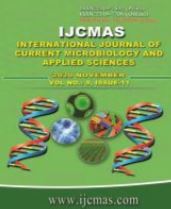


 National Academy of Agricultural Sciences (NAAS)
National Academy of Agricultural Sciences (NAAS)

|
PRINT ISSN : 2319-7692
Online ISSN : 2319-7706 Issues : 12 per year Publisher : Excellent Publishers Email : editorijcmas@gmail.com / submit@ijcmas.com Editor-in-chief: Dr.M.Prakash Index Copernicus ICV 2018: 95.39 NAAS RATING 2020: 5.38 |
Foxtail millet (Setaria italica (L.) Beauv.) is a potential climate resilient, C4 Panicoid crop. It is commonly known as Italian millet and is a staple food crop grown in some parts of China, India and Japan. Nutrient composition of millets is higher than the average nutrient composition in major cereals (Muthamilarasan and Prasad, 2015). Research studies are lagging behind in nutrient profiling of millets. Hence, the present study was carried out with one hundred genotypes of foxtail millet procured from ICRISAT mini core collection (Upadhyaya et al., 2011) for Lysine content. The range of values for these parameters ranged from 0.49-2.45 respectively, ISe 1610 (0.49g/100g of protein) recorded least amount of Lysine whereas ISe 1187 recorded highest amount of Lysine (2.45g/100g of protein). The study also reveals great variability existing among the collection of Italian millet accessions for Lysine that can be exploited to improve the cultivars to meet the nutritional requirements of humans.
 |
 |
 |
 |
 |